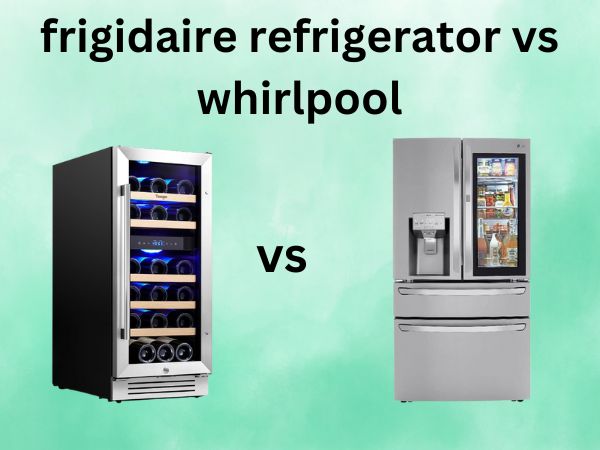Frigidaire Refrigerator vs Whirlpool [Which Brand Should You Choose in 2025?]
Are you standing in an appliance store, feeling overwhelmed by the seemingly endless options of refrigerators? Or perhaps you’re scrolling through online retailers, toggling between tabs of Frigidaire and Whirlpool models, wondering which one deserves a spot in your kitchen? You’re not alone in this refrigerator conundrum.
Choosing between Frigidaire and Whirlpool refrigerators is like deciding between two respected veterans in the cooling game – both have impressive track records, but each brings something different to your kitchen. In this comprehensive comparison, we’ll cool down the confusion and heat up your decision-making process with everything you need to know about these refrigeration titans.
Table of Contents
Understanding the Giants in Home Refrigeration
Before we dive into the nitty-gritty comparisons, let’s get acquainted with these household names that have been keeping our food fresh for generations.
Frigidaire: A Brief History and Overview
Did you know that Frigidaire practically invented the modern refrigeration game? Founded in 1918 as the Guardian Refrigerator Company, Frigidaire became so synonymous with refrigerators that people used to call all refrigerators “Frigidaires” – regardless of the brand! That’s some serious brand recognition.
Today, Frigidaire operates under the Electrolux umbrella but maintains its distinct identity in the appliance market. They’ve built their reputation on reliability, affordability, and consistent performance. While they might not always be the flashiest option in the showroom, they’re often the steady, dependable choice that won’t let you down or break the bank.
Frigidaire has continually evolved their technology while maintaining their core commitment to accessible quality. Their Gallery and Professional series aim to provide higher-end features while still hitting more moderate price points than many competitors.
Whirlpool: The Legacy and Innovation
Whirlpool, on the other hand, has been cooling and cooking since 1911, growing from a small company selling motor-driven wringer washers into one of the world’s largest home appliance manufacturers. If Frigidaire is the steady performer, Whirlpool positions itself as the innovative problem-solver.
Under the Whirlpool Corporation umbrella sits an impressive portfolio of brands including KitchenAid, Maytag, and Amana. This diverse family gives Whirlpool access to a wide range of technologies and design philosophies. The brand has leveraged this advantage to pioneer features like temperature-controlled drawers and advanced humidity control systems.
Whirlpool’s approach tends to emphasize cutting-edge features and technology, particularly in their mid to higher-end models, while still maintaining a presence in the budget-friendly space.
Key Differences Between Frigidaire and Whirlpool Refrigerators
Now that we understand the companies behind the cooling, let’s break down what actually sets these refrigerators apart when they’re standing side by side in your kitchen.
Design and Aesthetics
When it comes to appearance, Frigidaire typically embraces a more traditional, timeless aesthetic. Their designs often feature clean lines and unobtrusive styling that blends seamlessly into most kitchen décors. Even their more premium models maintain a certain understated elegance rather than making bold design statements.
Frigidaire refrigerators generally come in standard finishes like stainless steel, black stainless steel, and white. The handles tend to be substantial and practical, and the overall effect is one of reliable functionality rather than showstopping design.
Whirlpool, meanwhile, offers a slightly broader range of aesthetic options. While they also provide traditional designs, they’re more likely to incorporate contemporary elements and offer more variety in finishes, including fingerprint-resistant options that have become increasingly popular with families.
Some Whirlpool models feature more pronounced handles, curved design elements, or distinctive lighting that gives them a more modern appearance. Their premium lines often incorporate design flourishes that make them stand out more as statement pieces in your kitchen.
Available Models and Configurations
Both brands offer the full spectrum of refrigerator configurations, but there are subtle differences in their approaches and strengths across categories.
French Door Options
French door refrigerators have become the darlings of modern kitchens, and both brands have embraced this popular style.
Whirlpool really shines in the French door category, offering numerous models with innovative features like door-within-door access, adjustable middle drawers, and panoramic LED lighting. Their French door models tend to have more premium features and sophisticated climate control options.
Frigidaire’s French door offerings are competitive but generally more straightforward. They focus on delivering the core benefits of the French door design—wide shelving and eye-level fresh food access—without as many bells and whistles. This approach allows them to offer French door convenience at more accessible price points.
Side-by-Side Designs
When it comes to side-by-side models, Frigidaire has historically maintained a strong presence. Their side-by-sides often feature more generous freezer space than competitors and tend to excel at organization with thoughtfully designed door bins and adjustable shelving.
Whirlpool’s side-by-side refrigerators typically emphasize their water and ice dispensing systems, which often include advanced filtration and measured fill options. Their models may offer more tech integration but sometimes with slightly less freezer capacity than comparable Frigidaire units.
Top and Bottom Freezer Models
In the more traditional top and bottom freezer configurations, Frigidaire often has the edge in variety and value. Their bottom freezer models, in particular, offer an impressive balance of storage capacity and performance at their price points.
Whirlpool’s offerings in these categories are solid but fewer in number as they’ve shifted more focus to their French door and side-by-side lines. When they do offer top or bottom freezer models, they often include distinctive features like temperature-controlled deli drawers or enhanced humidity controls for produce.
Performance Comparison
Looking good is one thing, but keeping your ice cream frozen and your lettuce crisp is what really matters. Let’s look at how these brands perform in the cooling department.
Cooling Technology and Efficiency
Frigidaire refrigerators typically employ their “Even Temp” cooling system, which uses multiple air vents throughout the refrigerator compartment to maintain consistent temperatures. Their more premium models feature multi-flow air systems that aim to surround food with even, consistent cooling.
One of Frigidaire’s technological calling cards is their “PureAir Ultra II” air filter, which helps eliminate odors and keep your refrigerator smelling fresh—particularly useful if you store pungent cheeses or leftovers.
Whirlpool counters with their “Accu-Chill” temperature management system in many models, which provides fast cooling when needed (like after loading groceries) while minimizing energy use during normal operation. Their “FreshFlow” produce preserver works to extend the life of fruits and vegetables by absorbing excess ethylene gas that causes premature ripening.
In real-world performance, both brands generally maintain consistent temperatures, though Whirlpool models often recover more quickly after door openings in independent testing. Frigidaire units typically show less temperature variation between shelves, providing more consistent cooling throughout the entire refrigerator compartment.
Energy Consumption and Star Ratings
If utility bills keep you up at night, you’ll want to pay close attention to this section. Both manufacturers produce ENERGY STAR certified models, but there are some general patterns worth noting.
Frigidaire refrigerators typically consume slightly less energy in standard-size models. Their straightforward cooling systems often require less power to maintain consistent temperatures. This efficiency advantage is more pronounced in their mid-range models, where they’ve focused on optimizing performance without adding power-hungry features.
Whirlpool models, particularly those with advanced features like quick-chill options or extensive lighting, may consume marginally more energy. However, their premium models often incorporate adaptive defrost cycles and smart energy-saving features that help mitigate overall consumption.
For the most energy-efficient options from either brand, look specifically for models with the ENERGY STAR certification and check the yellow EnergyGuide label for estimated annual operating costs.
Noise Levels and Operation
Nothing ruins a midnight snack like a refrigerator that sounds like it’s preparing for takeoff. Fortunately, both brands have made significant strides in noise reduction.
Frigidaire refrigerators typically operate in the 38-42 decibel range, which is comparable to a quiet library or soft whispers. Their compressors tend to produce a steady, consistent hum rather than irregular or jarring noises.
Whirlpool models generally operate in a similar noise range, though their premium models with adaptive compressors can sometimes achieve even lower noise levels, around 35-40 decibels. However, some Whirlpool owners report more noticeable ice maker sounds, particularly in models with in-door ice dispensing systems.
Both brands have models that occasionally produce a “popping” sound during automatic defrost cycles, but this is normal operation rather than a concern. For the quietest operation from either brand, look for models that specifically advertise noise reduction technology.
Features Face-Off: Frigidaire vs Whirlpool
Modern refrigerators do a lot more than just keep things cold. Let’s see how these brands compare when it comes to the extra features that can make or break your daily experience.
Smart Technologies and Connectivity
In our increasingly connected world, even our refrigerators are getting smarter. But are Frigidaire and Whirlpool keeping pace?
Whirlpool has embraced smart home technology more enthusiastically, with numerous models offering Wi-Fi connectivity through their Whirlpool app. Their connected refrigerators can send alerts about power outages, filter replacements, and doors left ajar. Some premium models even integrate with voice assistants like Amazon Alexa and Google Assistant, allowing you to adjust temperatures or activate features hands-free.
Frigidaire has been more measured in their smart home integration. While they do offer connected models through their Frigidaire Connect technology, the feature set is more limited compared to Whirlpool. Their smart features tend to focus on practical applications like temperature monitoring and maintenance alerts rather than more elaborate integrations.
If you’re building a comprehensive smart home ecosystem, Whirlpool currently offers more options and better integration with other smart platforms. However, if you’re skeptical about the value of a connected refrigerator, Frigidaire’s more focused approach to smart features might actually align better with your needs.
Storage Options and Organization
When it comes to making the most of your refrigerator’s interior space, thoughtful design makes all the difference.
Frigidaire refrigerators often excel at customizable storage, with easily adjustable shelving and door bins that can accommodate items of various heights. Their “SpaceWise” organization system features modular components that can be rearranged to suit your specific needs. Many models include full-width deli drawers and humidity-controlled crispers that make organizing produce straightforward.
Whirlpool refrigerators typically offer similar adjustability but with some distinctive touches. Their “Infinity Slide” shelves can be pushed back partially to accommodate taller items without removing the entire shelf. Many models also feature temperature-controlled drawers with multiple settings for different food types—perfect for keeping deli meats at the ideal temperature or quickly chilling beverages.
Both brands offer decent door storage, though Frigidaire’s gallon-sized door bins tend to be slightly more robust and adjustable in more models across their line. Whirlpool counters with innovative features like can caddies and specialized bottle storage in select models.
Water and Ice Dispensers
For many households, the water and ice dispenser is the most frequently used refrigerator feature, making its design and functionality crucial.
Whirlpool generally offers more sophisticated water dispensing systems, including “Measured Fill” options that dispense exact amounts for recipes and “EveryDrop” filtration that reduces more contaminants than standard filters. Their ice systems often include options for both cubed and crushed ice, and some premium models feature “Fast Ice” technology that can produce up to 50% more ice when needed.
Frigidaire’s water and ice systems tend to be more straightforward but highly reliable. Their “PureSource Ultra II” filtration removes many common contaminants, and their dispensers are typically designed for easy one-handed operation. Some models feature their “SpaceWise” ice system, which maximizes refrigerator space by reducing the size of the ice maker mechanism.
One notable difference: Whirlpool has been quicker to address common ice maker issues in their designs, while some Frigidaire models have faced criticism for ice maker reliability in specific generations of products. However, Frigidaire has made significant improvements in recent years to address these concerns.
Durability and Reliability Analysis
A refrigerator is a long-term relationship, not a fling. Let’s examine which brand might stand by you longer through the years.
Consumer Reports and repair technicians generally rate both Frigidaire and Whirlpool as above-average in reliability, though with different strengths and weaknesses. Based on aggregate data from multiple independent sources, Frigidaire refrigerators typically have slightly fewer service calls in the first five years, particularly for their more basic models with fewer complex features to malfunction.
Whirlpool refrigerators tend to have longer overall lifespans, often reaching 15-20 years with proper maintenance, compared to Frigidaire’s typical 13-17 year lifespan. However, Whirlpool units with advanced features like external water dispensers or connected technology may require more maintenance over their lifetime.
Warranty Offerings
Warranty coverage can tell you a lot about how confident a manufacturer is in their product. Both brands offer standard one-year limited warranties covering parts and labor for defects in materials or workmanship. This is fairly standard across the industry.
Whirlpool edges ahead slightly with extended coverage on specific components: they typically offer five-year coverage on the sealed refrigeration system (compressor, evaporator, condenser, etc.) and ten-year coverage on their linear compressor models. This longer coverage on critical components provides some additional peace of mind.
Frigidaire’s standard warranty is the one-year comprehensive coverage, with most models also including a limited second through fifth year warranty on the sealed system components. They don’t typically offer the extended compressor coverage that Whirlpool does on premium models.
Both manufacturers offer extended warranty options for purchase, which can be worthwhile considering the average repair cost for modern refrigerators often exceeds $300 per incident.
Common Issues and Solutions
Every refrigerator brand has its typical trouble spots. Being aware of these can help you make an informed decision and potentially avoid headaches down the road.
Frigidaire refrigerators most commonly experience issues with:
- Ice maker functionality in some model years
- Temperature fluctuations in the fresh food section
- Water dispenser leaks after several years of use
Whirlpool refrigerators more frequently encounter:
- Control board electrical issues in feature-rich models
- Door seal degradation, particularly in humid environments
- Cooling fan noise development over time
It’s worth noting that both brands have addressed many of these issues in their newest generations of products. Frigidaire has redesigned their ice making systems, while Whirlpool has improved their control board shielding and door seal materials.
Price Comparison and Value for Money
Let’s talk dollars and cents – how do these brands compare when it comes to your wallet?
Budget-Friendly Options
In the entry-level category (roughly $700-1,000), Frigidaire typically offers more features for the price. Their basic top-freezer models often include adjustable shelving, humidity-controlled crispers, and decent energy efficiency at price points where Whirlpool models might have fewer adjustable components.
Whirlpool’s budget offerings focus on reliability and straightforward operation rather than features. While they might offer fewer bells and whistles at this price point, their basic models are often praised for their quiet operation and consistent cooling.
For the extremely budget-conscious shopper looking for a simple refrigerator under $800, Frigidaire generally provides better value with more adjustable interior components and slightly larger capacity for similar prices.
Premium Models Worth the Investment
At the higher end of the spectrum ($1,800-3,000+), Whirlpool typically delivers more innovative features and technology integration. Their premium French door and side-by-side models often include advanced climate control systems, specialized storage solutions, and more sophisticated water/ice dispensing options than comparably priced Frigidaire models.
Frigidaire’s premium offerings emphasize streamlined luxury rather than technological complexity. Their high-end models feature enhanced finishes (like their smudge-proof stainless steel), improved lighting systems, and refined interior designs, but typically fewer technological advancements than Whirlpool’s premium lines.
For tech enthusiasts willing to spend over $2,500, Whirlpool generally offers more cutting-edge features. For those prioritizing elegant design and straightforward operation in a premium package, Frigidaire’s high-end models might represent better value.
Real User Experiences and Satisfaction
What are actual owners saying after living with these refrigerators day in and day out?
According to aggregated customer reviews from major retailers and consumer reporting organizations, both brands maintain similar overall satisfaction ratings, typically averaging between 4.1-4.3 stars out of 5 across their model ranges.
Frigidaire owners most frequently praise:
- The consistency of temperatures throughout the refrigerator
- The thoughtful organization of storage space
- The value received for the price paid
- Quieter operation than expected
Common criticisms of Frigidaire models include:
- Ice maker reliability in specific model years
- Less intuitive control interfaces on some models
- Slightly less robust door hinges over time
Whirlpool owners most frequently appreciate:
- The longevity of their refrigerators
- The effectiveness of specialty features like temperature-controlled drawers
- Better-than-average water dispensing systems
- Responsive customer service
Recurring complaints about Whirlpool refrigerators include:
- Higher repair costs when issues do occur
- More complicated troubleshooting due to advanced features
- Door seal issues in some environments
Making Your Decision: Which Brand Is Right for You?
With all these comparisons in mind, let’s break down which brand might better serve specific types of consumers.
Best for Budget-Conscious Shoppers
If you’re working with a tight budget but still want quality cooling, Frigidaire typically offers more features and capacity at lower price points. Their entry-level and mid-range models provide excellent cooling performance without unnecessary complexity that could drive up costs.
For maximum value under $1,200, Frigidaire’s bottom freezer and side-by-side models often provide the best balance of space, features, and reliability without breaking the bank.
Best for Tech Enthusiasts
If you’re building a connected smart home and want your refrigerator to be part of that ecosystem, Whirlpool has a clear advantage. Their more extensive smart home integration, coupled with innovative features like precise temperature zone control and advanced water filtration systems, makes them the preferred choice for tech-forward consumers.
Whirlpool’s premium French door models with Wi-Fi connectivity and touchscreen controls represent the cutting edge of refrigeration technology for those willing to invest in it.
Best for Large Families
For households feeding many mouths, storage capacity and organization become paramount. Here, the decision is less clear-cut and depends on your specific needs.
Frigidaire might have the edge for families who store lots of frozen foods, as their freezer compartments typically offer slightly more usable space and better organization. Their side-by-side models, in particular, excel at providing accessible frozen food storage.
Whirlpool could be preferable for families who prioritize fresh food storage, as their crispers typically maintain humidity better, and their specialty drawers offer more precise temperature control for extending the life of produce, meats, and dairy.
FAQs About Frigidaire and Whirlpool Refrigerators
1. How long do Frigidaire and Whirlpool refrigerators typically last?
Whirlpool refrigerators generally have a slight edge in longevity, with an average lifespan of 15-20 years with proper maintenance. Frigidaire models typically last 13-17 years. However, lifespan varies significantly based on usage patterns, maintenance, and the complexity of the model (simpler models often last longer).
2. Are Frigidaire or Whirlpool refrigerators more energy efficient?
In comparable models, Frigidaire refrigerators often consume slightly less energy, particularly in their mid-range offerings. However, both manufacturers produce ENERGY STAR certified models that exceed federal efficiency standards. For the most accurate comparison, always check the yellow EnergyGuide label that displays estimated annual energy consumption and operating costs.
3. Which brand offers better warranty coverage?
Whirlpool typically offers slightly better warranty protection, with five-year coverage on sealed system components and ten-year limited coverage on linear compressors in select models. Frigidaire offers the industry-standard one-year full coverage with limited sealed system coverage in years two through five. Both manufacturers offer extended warranty options for purchase.
4. Can I install a water line to my Frigidaire or Whirlpool refrigerator after purchase?
Yes, most models from both manufacturers can be connected to a water line after purchase if they’re designed with ice makers or water dispensers. However, this usually requires professional installation unless you have plumbing experience. Remember that not all models are designed for water line connection—check your specific model’s specifications before purchase if this feature is important to you.
5. Which brand is better for smart home integration?
Whirlpool currently offers more comprehensive smart home features and better integration with popular platforms like Amazon Alexa, Google Assistant, and popular smart home hubs. Their connected refrigerators provide more remote control capabilities and monitoring options than Frigidaire’s more limited smart offerings. If creating a connected kitchen is a priority, Whirlpool currently has the advantage in this area.
Conclusion
In the Frigidaire vs. Whirlpool refrigerator showdown of 2025, there’s no absolute winner – just different strengths that might align better with your specific needs and preferences.
Frigidaire offers excellent value, straightforward operation, and thoughtful organization. Their refrigerators particularly shine in the budget to mid-range categories, where they often provide more features per dollar than competitors. If you value practical functionality without unnecessary complexity, Frigidaire might be your ideal cooling companion.
Whirlpool excels in technological innovation, longevity, and premium features. Their refrigerators tend to last longer and offer more sophisticated solutions to food storage challenges. If you’re interested in cutting-edge features and smart home integration, Whirlpool will likely serve you better.
Ultimately, the best refrigerator is the one that fits your specific kitchen layout, budget, and daily habits. Consider how you use your current refrigerator—what you love about it and what drives you crazy—and use those insights to guide your choice between these two outstanding brands.




